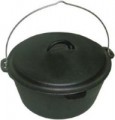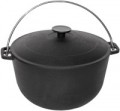Size
The main size of the dishes.
Most often, only one size is indicated here, but which one depends on the shape (see above). So, for round cauldrons, the diameter is given, and for oval and rectangular ducks — the length (the largest of the dimensions). Anyway, this indicator allows you to determine two points: firstly, how suitable is the container for “large-sized” ingredients (for example, a half carcass or a whole carcass of a bird); secondly, whether the dishes will fit on the stove, in the oven, microwave, etc. In addition, other dimensions may be indicated in the notes (for round dishes — height, for other shapes — length), which makes it even easier to estimate the capacity and space occupied.
As for specific values, a size
of up to 30 cm is considered small — however, in many cases this turns out to be quite enough, so a lot of such dishes are also produced.
31 – 35 cm can be called an average,
36 – 40 cm is above average, and in the most dimensional thick-walled household dishes, the size can
exceed 40 cm. It should be noted that the volume (see below) also depends on the width and height of the product, so there is no direct connection between the capacity and the claimed size: for example, dishes for 7-10 liters are found among all the categories mentioned above — from " up to 30 cm” to “more than 40 cm”. Thus
..., when choosing, it is worth not only taking into account the indicated size and volume, but also specifying specific dimensions.Volume
Nominal volume of dishes. Usually, it is indicated by the working volume — the actual amount of content that can fit inside without problems when used for its main purpose.
The main criterion for choosing this indicator is the volume of the planned cooking. So, dishes
up to 4 liters are intended mainly for small families of 2 – 3 people.
4-6 liter containers are already suitable for eating for 4-5 people. A capacity of
7 – 10 liters allows (especially in the case of ducklings) to fit inside a half carcass, or even a whole carcass of a bird. And the largest dishes will hold
more than 10 liters(in some cauldrons — up to 30 liters or more); such products may already come in handy at large family celebrations, mass events and in cafes / restaurants
Just in case, we recall that the reverse sides of a large volume are bulkiness, corresponding weight, as well as increased cost. In addition, for the effective use of such dishes, you need the appropriate space and equipment. Therefore, it is far from always that a larger volume is the best choice — it is worth considering the real needs and cooking conditions.
Also note that dishes similar in volume can have different shapes and proportions. For details on the form, see above; and proportions are associated with many nuances that determine the effectiveness of dishe
...s in a given situation. For example, a lower and wider cauldron will heat up more evenly when used on a kitchen burner, while a taller cauldron will work better in the oven. Detailed recommendations on this subject can be found in special sources.Wall thickness
The thickness of the walls of the goose or cauldron (see "Type").
Thick walls provide uniform heating and allow the dishes to accumulate more heat. Both are extremely important for stewing, languishing, and other similar cooking methods, for which thick-walled dishes were invented at one time. Therefore, from this point of view, we can say that the thicker the walls of the dishes, the better. On the other hand, a large thickness significantly affects the weight, especially when it comes to capacious containers, and such models are much more expensive.
In the most thin-walled modern goose and cauldrons, the wall thickness is about 3 – 4 mm — this is quite enough for the dishes to cope with their task normally. However, more demanding and sophisticated cooks are advised to have a thicker wall. At the same time, one should not forget that the performance characteristics of dishes also strongly depend on the material (see below), and only models made from the same material can be compared with each other in terms of wall thickness.
Country of origin
The country of origin of the brand under which the goose or cauldron is presented on the market. Usually, it is indicated by the "homeland" of the manufacturing company or by the location of its headquarters.
There are many stereotypes associated with the “nationality” of brands and products, but most of them have no basis nowadays. First, the actual place of production is often different from the brand's country of origin. Secondly, the quality of the goods depends not so much on geography, but on the policy of a particular company and how carefully this very quality is controlled in it. Therefore, you should pay attention to the country of origin of the brand only if you fundamentally want or (do not want) to support a manufacturer from a certain state. Quality is best judged by the reputation of a particular brand and the general price category.

